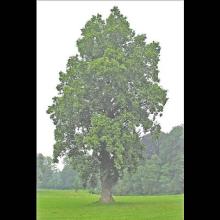Liriodendron tulipifera
Common name:
Tulip tree
Genus:
Liriodendron
Family:
Magnoliaceae
Order:
Magnoliales
Liriodendron tulipifera
Common name:
Tulip tree
Genus:
Liriodendron
Family:
Magnoliaceae
Order:
Magnoliales
Liriodendron tulipifera
Common name:
Tulip tree
Genus:
Liriodendron
Family:
Magnoliaceae
Order:
Magnoliales
Family-Plantae: Magnoliaceae
The Magnoliaceae (/mæɡˌnoʊliˈeɪsii/) are a flowering plant family, the magnolia family, in the order Magnoliales. It consists of two genera: Magnolia and Liriodendron (tulip trees).
Unlike most angiosperms, whose flower parts are in whorls (rings), the Magnoliaceae have their stamens and pistils in spirals on a conical receptacle. This arrangement is found in some fossil plants and is believed to be a basal or early condition for angiosperms. The flowers also have parts not distinctly differentiated into sepals and petals, while angiosperms that evolved later tend to have distinctly differentiated sepals and petals. The poorly differentiated perianth parts that occupy both positions are known as tepals.
The family has about 219 species and ranges across subtropical eastern North America, Mexico and Central America, the West Indies, tropical South America, southern and eastern India, Sri Lanka, Indochina, Malesia, China, Japan, and Korea.
Genera
The number of genera in Magnoliaceae is a subject of debate. Up to 17 have been recognized, including Alcimandra, Lirianthe, Manglietia, Michelia, Pachylarnax, Parakmeria, Talauma and Yulania. However, many recent studies have opted to merge all genera within subfamily Magnolioideae into the genus Magnolia. Thus, Magnoliaceae would include only two extant genera, Magnolia and Liriodendron.
Description
The monophyly of Magnoliaceae is supported by a number of shared morphological characters among the various genera in the family. Most have bisexual flowers (with the exception of Kmeria and some species of Magnolia section Gynopodium), showy, fragrant, radial, and with an elongated receptacle. Leaves are alternate, simple, and sometimes lobed. The inflorescence is a solitary, showy flower with indistinguishable petals and sepals. Sepals range from six to many; stamens are numerous and feature short filaments which are poorly differentiated from the anthers. Carpels are usually numerous, distinct, and on an elongated receptacle or torus. The fruit is an etaerio of follicles which usually become closely appressed as they mature and open along the abaxial surface. Seeds have a fleshy coat, aril, and color that ranges from red to orange (except Liriodendron). Magnoliaceae flowers are beetle pollinated, except for Liriodendron, which is bee pollinated. The carpels of Magnolia flowers are especially thick to avoid damage by beetles that land, crawl, and feast on them. The seeds of Magnolioideae are bird-dispersed, while the seeds of Liriodendron are wind-dispersed.
Reference: Wikipedia

